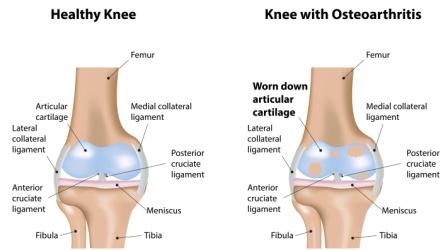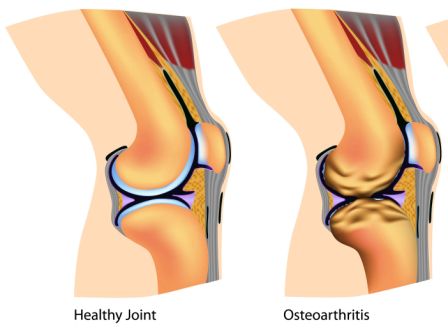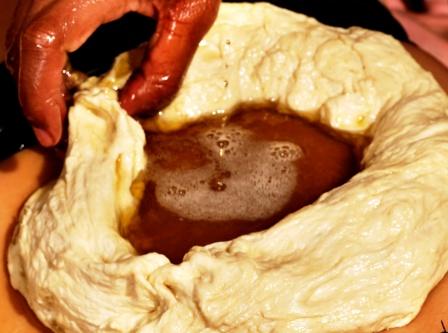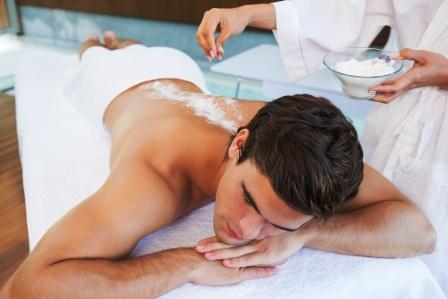Effective Ayurveda treatments for Knee Osteo Arthritis (SandhiVata)
Article by Dr Raghuram Y.S. MD (Ay)
Knee joints are the key joints of locomotion. When they get hurt, injured, degenerated or inflamed they give pain and makes life difficult. Even the simplest of day-to-day activities seems to be a burden when our knee joints have given way.
There are many diseases which afflict the knee joint and render it passive; osteoarthritis (OA) is the leading one. Osteoarthritis is found to afflict the joints, mainly knee joint in the transition period between the middle age and old age. It is common in women who are progressing towards menopause or those who have already set into it.

As a clinician I deal at least a couple of patients per day who suffer from knee pain due to osteoarthritis of the whole lot of patients I see. I could well say that ‘Every home has a case of osteoarthritis’ and it would not be an exaggeration. The disease is on a rise due to our erratic lifestyle and unwholesome food habits.
Ayurveda has best remedies and treatments to offer towards effective management of osteoarthritis knee. ‘Sandhigata Vata’ a painful condition of the joints explained in Ayurveda can be compared to Osteoarthritis due to proximity of symptoms. When SandhiVata occurs in knee joint (janu sandhi), it is called as ‘Janu Sandhi-gata Vata’.
Table of Contents
Osteoarthritis
What is Osteoarthritis?
It occurs due to the wearing and tearing of the protective cartilage on the ends of your bones over a period of time. OA thus results from the breakdown of joint cartilage and underlying bone. OA can affect and damage any joint in the body.
Important aspects of OA –
- Osteoarthritis commonly afflicts the joints of the hands, Joints near the finger ends, base of the thumb, neck, lower back, hips, knees and spine.
- Joints on one side of the body are often more affected than those on the other.
- The most common symptoms are joint pain and stiffness. Joint swelling and decreased range of movements are also present in many cases.
- It gradually worsens with time and no cure exists.
- Active lifestyle, maintaining healthy body weight, effective medicines and treatments may help to slow down the progression of osteoarthritis and thus may help to improve pain and joint function.

Sandhigata Vata
Osteoarthritis is called Sandhigata Vata / Sandhi Vata in Ayurveda. It means a condition in which morbid Vata is located in the joints and destroys the joints.
The vitiated Vayu on getting lodged in the joints of the body, causes Sandhigata Vata
The signs and symptoms of Sandhigata Vata are –
- Shula (pain)
- Atopa (abnormal sounds due to damage of joints or crepitus)
- Vata purna driti sparsha – Sounds resembling that made when we rub against a balloon or transparent container filled with air
- Shotha – Swelling
- Prasarana Akunchanayoho pravritti savedana – Painful movement of the joints including extension and flexion
Janu Sandhigata Vata
Knee osteoarthritis or Janu SandhiVata –
Common causes:
Old age
Increased body weight
Heredity – includes genetic mutations that might make a person more likely to develop osteoarthritis of the knee. It may also be due to the inherited abnormalities in the shape of bones that surround the knee joint.
Gender – women of 55 years of age or older are more likely to develop osteoarthritis than men
Repetitive stress injuries – mostly related to the nature of the job, people involved in occupations that include lot of activity which causes stress on the joint are causative. These include activities and jobs involving kneeling, squatting or lifting heavy weights.
Athletics – athletes involved in soccer, tennis, long-distance running carry risk of developing OA of knee.
Other illnesses – people with rheumatoid arthritis, metabolic disorders such as iron overload or excess growth hormone also carry the risk of hiring OA
Symptoms
Symptoms of Knee Osteoarthritis –
The symptoms of knee osteoarthritis are no different from the symptoms of osteoarthritis. But the most important manifestations are as below mentioned –
- Pain – in knee joints when you are active, gets better with rest
- Swelling of the joints
- Feeling warmth in the joint
- Stiffness – especially early in the morning or after long periods of inactivity, especially sitting
- Decreased mobility – full range of movements at the knee joint cannot be performed
- Creaking – crackly sounds are heard when you move the joints
Related reading – OsteoArthritis: Symptoms, Prevention, Lifestyle tips, Ayurvedic treatment
Bahya Chikitsa
Bahya Chikitsa (External treatment)
Abhyanga (Therapeutic / Preventive Herbal Oil Massage)
Best oils used for Abhyanga:
- Tila Taila (Sesame oil)
- Ksheerabala Tailam
- Murivenna
- Pinda Tailam
- Mahanarayana Tailam
- Prabhanjana Vimardhana Tailam
- Mahamasha Tailam
- Dhanwantaram Tailam
- Kottamchukkadi Tailam
- Guggulutiktakam Ghritam etc.
Swedana (Fomentation / Sudation / Sweating therapy)
Swedana means a treatment procedure in which sweating is induced. Swedana is usually done after Abhyanga and or Snehapana (administration of medicated oils and ghee for oral consumption in metered doses)
After Swedana, the cells get activated and flush the toxins away. The cellular metabolism improves and we feel light and at ease. Swedana done after abhyanga /snehana enables free circulation in the joints, removes pain, stiffness and swelling, strengthens and rejuvenates the joints, eases movements.
There are many types of Swedana as explained in Ayurvedic texts. But the below mentioned types of Swedana are generally practiced in the treatment of osteoarthritis –
Bashpa Sweda – steam therapy
Ekanga Bashpa Sweda or Nadi Sweda –
When the pain is limited to a part of the body or when individual joints are afflicted with osteoarthritis like in osteoarthritis of knee joint, Ekanga Bashpa Sweda is preferred.
This procedure is carried out by boiling pain alleviating drugs like Rasna (Alpinia galangal), Eranda (Ricinus communis), Dashamula (10 roots), Devadaru (Cedrus deodara) etc in a container with lid; say for example a pressure cooker. The nozzle of the cooker is connected with a heat resistant tube. When the contents in the vessel or cooker are boiled to optimum, the steam is released through the opening of the tube. The painful part or joint is exposed to the steam. This should be done after having subjected the knee joint with abhyanga (herbal oil massage)
Pinda Sweda (Bolus Fomentation) –
In Pinda sweda, the medicaments, generally hot or boiled to tolerable temperature are tied in a cloth so as to make a bolus. The bolus is gently rubbed over the afflicted joints. Heat is provided until sweating occurs. Pinda sweda is generally done as a local fomentation, applied on the pain afflicted joints. Pinda sweda is highly beneficial in osteoarthritis of knee joints.
Churna Pinda Sweda (Podikkizhi) –
Churna means herbal powder, Pinda means bolus, Sweda means fomentation. Herbal powders having analgesic, anti-inflammatory and hygroscopic properties are filled and tied in a sterile cloth so as to form a bolus. Read more – Podikizhi – Churna Pinda Sweda Treatment Procedure, Benefits
In osteoarthritis of knee joints, wet form (oil dipped) of churna pinda sweda is generally preferred as there is degeneration and there is want of lubrication.
Herbal powders used for Churna Pinda Sweda are:
- Rasnadi Churna,
- Jatamayadi Churna,
- Ellumnishadi Churna,
- Grihadhoomadi Churna,
- Kolakulattadi Churna etc
Patra Pinda Sweda (Leaf bolus fomentation) –
The fresh leaves of the Vata alleviating / pain relieving herbs are collected and sliced. Ex. Leaves of Eranda (Ricinus communis – castor plant), Nigundi (Vitex nigundo), Arka (Calotropis gigantean), etc are sliced.
- The sliced leaves are fried in herbal oil.
- Grated coconut, sliced lemon, Rasnadi Churna, Haridra (Turmeric powder), Methika (fenugreek), Saindhava Lavana (rock salt), Eranda Taila (castor oil) are also added and fried.
- The sliced leaves are tied in a bolus to form a Patra Pinda (Leaf bolus).
- The leaf bolus is dipped in warm oil
- The temperature of the bolus is tested and used for giving fomentation.
- The bolus is rubbed on the affected part gently (as good as massaging with bolus).
Read related: Patra Pinda Sweda: Ela Kizhi massage Preparation, Procedure, Benefits
Shashtika Shali Pinda Sweda –
Fomentation with Shashtika Rice (rice grown in 60 days duration) is called shashtika shali pinda sweda. The rice is processed with milk and medicinal decoction. The processed rice is tied in boluses and used for treatment. The boluses are dipped in milk processed with pain alleviating decoctions and rubbed over the sore joints continuously for 30-45 minutes. It is preferred when there are signs of severe Vata vitiation and degeneration of knee joints, muscles and other soft tissues around the knee joints. It rejuvenates, nourishes and strengthens the bones, muscles and soft tissues.
Read related: Navarakizhi: Shashtika Shali Pinda Sweda Procedure, Benefits
Dhara / Seka (Pizhichil) –
Dhara means to pour in streams. In this, medicaments including herbal oils and processed milk is poured in streams over the painful knee joints along with gentle stroking for a fixed duration. This is highly effective in combating morbid Vata, Pitta and Rakta in the knee joints. The same oils useful in Abhyanga shall be administered in the form of Dhara.

Janu Vasti
Thus Janu Vasti is a treatment in which ‘pain relieving’ warm medicated oils are poured and pooled for a fixed duration of time in a compartment or a cabin constructed over the knee joints using wet flour of black gram.
Janu Vasti is pain relieving oil-pooling treatment conducted for knee pain associated with osteoarthritis of knee joint.
Read related: Janu Basti Ayurvedic Therapy – Procedure, Benefits
Sandhi-Pichu
A larger piece of cotton swab (pichu) or sterile gauze is dipped in medicated oil and or ghee, kept over the painful knee joint and bandaged. It is left in place for a prescribed duration, varying from 45 minutes to 3-4 hours depending on the severity of symptoms before it is removed. This is done every day. This will nourish the bones, muscles, joints and tissues around the knee joint. It will prevent further degeneration, reduces inflammation, heals pain and relieves stiffness of knee joints. The oils mentioned in Abhyanga could be used in Sandhi Pichu.
Sandhi Lepa
Lepa means application. Powders of dry herbs which alleviate pain are taken and made into paste. The paste is applied over the afflicted knee joints. The paste is allowed to stay in place for a prescribed period or till the paste starts to dry.
Generally Vata is predominant in Sandhigata Vata. Therefore the lepa should be applied hot or warm. This is antagonistic to Vata. This helps even if Kapha is involved along with Vata as evident by associated stiffness and effusion leading to swelling of knee joints in some osteoarthritis cases.
If inflammatory changes are evident it indicates involvement of Pitta along with Vata. Here we can find burning sensation and increased heat in the knee joints along with pain. This happens even if vitiated rakta is involved along with Vata. Such condition is found when osteoarthritis develops in patients who are already suffering from amavata (rheumatoid arthritis of knee joint). In these conditions the lepa shall be applied cold. The common medicines which are used for Lepa are –
- Rasnadi Churnam
- Kottamchukkadi Churnam
- Grihadhoomadi Churnam
- Ellumnishadi Churnam
- Dashanga Lepam etc
Upanaha
Upanaha means poultices. The herbal powders mentioned in lepa can be used in Upanaha also. The churnas are mixed with suitable medicated oils; salt etc. so as to obtain their paste, the medicines are applied and tied around the sore knee joint or joints such that the medicines lie in contact of the painful part for a prescribed duration (ranging from 1 hour to 4 hours depending on the severity) until they are removed. They are many times left in position overnight and removed in the morning.

Udwarthana –
Excessive weight gain is one of the chief causative or triggering and risk factors for osteoarthritis. Reduction of weight has been seen to reduce the burden on the knee joints and ease the pain and stiffness. Therefore weight reduction should be one of the main strategies in the treatment of osteoarthritis especially in obese individuals.
Udwarthana – herbal powder massage is the best option for reducing belly fat and weight.
Read related: Udvartana – Ubtan: Benefits, Types, How To Do
Abhyantara Chikitsa
Abhyantara Chikitsa (Internal treatment)
Approach towards healing any disease should be comprehensive and total. In diseases like osteoarthritis results will be good and recovery will be quick if the treatments are carried on biphasic ways i.e. external treatments along with internal treatments. Oral medications, diet and lifestyle management and immune-modulators (Rasayanas) also come into the picture. But since we are discussing only about the best treatments for osteoarthritis we shall not touch the other part. Having discussed about the best external treatments, we shall now see the best internal treatments which can be administered to combat osteoarthritis effectively.
Internal treatments for osteoarthritis includes some of the Panchakarma (5 treatment procedures which are used in body cleansing / detoxification) treatment procedures which should be skilfully chosen as per the condition of the dosha and the diseased.
Snehapana
Sneha means medicated oil or ghee, Pana means intake. Snehapana is a procedure in which the patient is made to drink metered doses of oils and ghee which are processed with medicines. This is given in 3 forms:
Shodana Sneha –
- Here the selected sneha is given in higher doses.
- The intention is to cause saturation of sneha in the body.
- The dosage is increased every day until all the cells of the body get saturated or the symptoms of proper administration (Samyak Snigdha Lakshanas) are obtained or until the patient develops aversion towards the medicine.
- It is usually given early in the morning on empty stomach.
- It is given for patients for whom Shodana (body cleansing treatments like vamana or virechana has been planned.
- After the body cells have been saturated with the Sneha, Swedana (whole body steaming) is given followed by administration of Vamana (therapeutic emesis) and or Virechana (Therapeutic purgation) is given.
In osteoarthritis since there is severe degeneration involved with either swelling, high levels of sneha is needed. Sneha is antagonistic to the degeneration process caused by excessive ruksha guna (dry quality) and khara guna (rough quality) of vitiated Vata. Virechana is one of the best treatments for osteoarthritis. To prepare the patient for virechana, shodhana sneha is obviously necessary. Shodhana and shodhana sneha is useful choice in severe, progressive and or chronic osteoarthritis.
Shamana Sneha –
This will be fruitful to subside the disease or degeneration process in the earlier stages of osteoarthritis, having mild to moderate symptoms and when the disease is more acute in nature. The same medicaments used in Shodana Sneha are given in smaller doses. It is also preferred when the extent and strength of the disease and diseased are low or moderate. It is given when the patient feels hungry, before food. The intention is to pacify the vitiated Doshas and not to expel them.
Brimhana Sneha –
The sneha is given for strengthening purposes and also for promoting bulk of the muscles around the knee joint or joints. The medicated oil or ghee is given mixed with food in a small quantity.
Nitya Snehapana –
- In this format, small metered dose of Snehana is given on a daily basis.
- It is given either first thing in the morning or at bedtime usually mixed in hot milk or gruels.
- This method is followed when the patient is not able to take higher doses or is not fit for Panchakarma procedures, mainly virechana.
- It acts as a lubricant and rejuvenates the joints and soft tissues.
- It also helps in tackling the morbid Vata and Pitta which are causing joint pains.
Important medicines used for Snehapana –
- Guggulutiktakam Ghritam
- Tiktakam Ghritam
- Indukantham Ghritam
- Bala Tailam
- Rasnadi Ghritam
- Mahamasha Tailam
- Brihat Chagaladya Ghritam
- Amritaprasha Ghritam etc.
Virechana
Virechana means therapeutic purgation. Virechana is given after the administration of Snehapana and Swedana. Virechana expels the morbid dosha’s especially pitta and vata, thus preventing or curing the osteoarthritis.
Nitya virechana –
This is a variant of Virechana where in the medicines which have a laxative property are given in low doses on a daily basis. This will expel morbid doshas on a daily basis. Apart from expelling morbid vata and pitta, it also relieves pain, inflammation and stiffness of the degenerating joints in osteoarthritis.
Best medicines used for Virechana (depending on the morbid dosha and morbidity):
- Gandharvahastadi Kashayam
- Gandharvahastadi Eranda Tailam
- Nimbamritadi Eranda Tailam
- Higutriguna Tailam
- Shaddharana churnam
- Trivrit Leha
- Sukumara Leha
- Kalyana Gulam
- Sukumara Ghritam
- Sukumaram Kashayam
- Hingutriguna leham
- Triphala Churnam
- Narayana churnam etc
Basti:
Vasti means medicated enemas. Basti is said to be the best treatment for vitiated Vayu and related painful conditions, including osteoarthritis. Vasti strengthens the joints and soft tissues, rejuvenates health, aids fast healing and prevents recurrence. Vasti also helps in enabling smooth movements at the knee joints.
Many times, constipation and accumulation of gases in the belly is the cause for joint pain. Virechana and Vasti act as effective purgatives and relieve the mentioned conditions.
Vasti is given in the below mentioned forms:
Asthapana Vasti (Kashaya Vasti) –
Herbal decoctions or milk (ksheera vasti) processed with decoctions is given as enemas.
Below mentioned are some of the best Asthapana Vasti’s in osteoarthritis –
Erandamuladi Kashaya Vasti
Dashamula Kashaya Vasti
Dashamula Ksheera Vasti
Mustadi Yapana Vasti etc.
Anuvasana Vasti –
Medicated oils or ghee is used for enemas. It is given in combination with Asthapana Vasti (alternatively).
Matra Vasti –
It is also a variant of Anuvasana Vasti but given in small doses. It can be given on a daily basis until the pain and associated symptoms related to osteoarthritis get resolved. Matra vasti lubricates the joints and relieves pain and associated conditions. It also helps in preventing the progression of the disease process and degeneration.
Best medicines used for Anuvasana and Matra Vasti are –
- Guggulutiktakam Ghritam
- Tiktakam Ghritam
- Ksheerabala Tailam
- Mahamasha Tailam
- Sahacharadi Tailam
- Brihat Saindhavadya Tailam
- Bala Tailam etc.
Note – Tikta Ghrita – Ghee processed with decoction of bitter drugs shall be used for drinking purpose and also for enemas
Yogas from Sahasra Yoga Text book
- Panchatiktaka guggulu gritha
- Rasna Sunthyadi Kashaya
- Karaskara Ghrita
Just before Finish –
Many conditions are stubborn and do not surrender just to ‘pain alleviating medicines’. They need to be attacked and addressed with a multi-dimensional approach. The treatment options available in Ayurveda as summed up and discussed in this article are really useful in combating osteoarthritis. All the above said treatments are not needed at once but may be needed at different stages. Each treatment has a different purpose and should be skilfully administered. The choice and combinations of treatments is left out purely to the brilliance and judgement of the Ayurvedic physician who handles osteoarthritis.
Osteoarthritis progresses with age and makes you crippled and dependant. It clouds the possibilities of doing the easiest of daily activities and makes you physically and mentally disturbed. But it doesn’t come without giving you the warning signs. When you find that your knee joints are at discomfort, may be of a smaller magnitude make sure that you get it attended and addressed in quick time. With this, you would have made sure that you have taken a good caution and aborted the progression of the disease to its worst form!!
Get your sore knee joints healed with natural approach…with the help of Ayurvedic treatments!!!
Click to Consult Dr Raghuram Y.S. MD (Ayu)










4 comments
jayaselvar
Sir, thank you very much for your detailed and useful article. I have some doubts: 1) Is it possible to regenerate (regrow) the cartilage that is already thinned? What is the method or medicine to do it? 2) Can somebody manage with decent degree of flexibility and load bearing, even with completely worn out cartilage?
Thank you sir.
Selvaraj.
jayaselvar
Thank you very much Sir for your kind reply. I will do the needful, based on your inputs. Thanks again.
Stini
Sir, I have some doubts: 1) Is it possible to regenerate (regrow) the cartilage that is already thinned?
Dr J V Hebbar MD(Ayu)Author
yes.